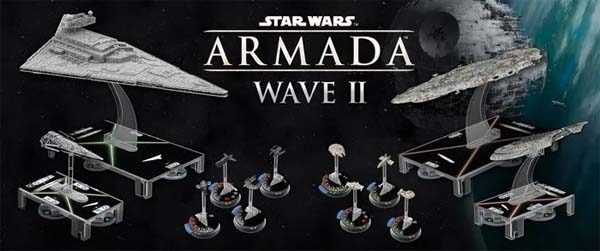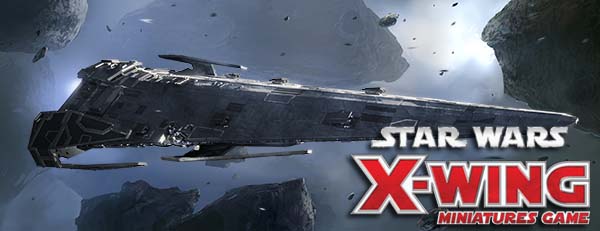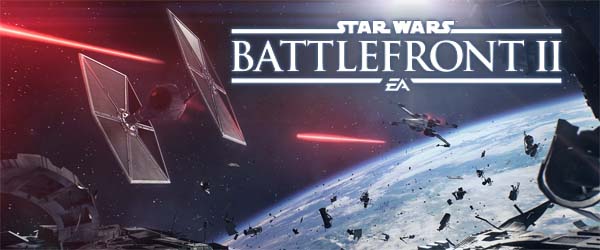
I might have been a bit unfair to X-Wing when I originally reviewed the Star Wars: Armada core set. I gave Armada a pretty glowing recommendation and praised it for giving the player more meaningful decisions and for fixing a handful of complaints that I had with X-Wing. But I kind of neglected the fact that the Armada core set has pretty much the same fundamental problem that stopped me from giving a similarly high grade to X-Wing: the limited content of the package.
X-Wing had three small ships, and a handful of alternate pilots and upgrades to add some replayability. But the game really needed some expansions to really come into its own. And I pointed that out in my review of X-Wing's core set, and docked its final score.
Don't get me wrong, Armada does offer more content in its core set than X-Wing did! It also has three ships, along with alternate ship cards and upgrades. But those three ships are different sizes and strengths, and there's ten fighter squadrons to go along with them. Armada's core set also includes the objective cards that helped to give that game more structured play, while X-Wing only had a couple of scenarios. So I still think that the Armada core set offers more value than the X-Wing core set.
However, I also knew that having a roster of expansion ships would improve the game, and I baked that assumption into my review for Armada. This may have been unfair to X-Wing, especially considering that the Armada core set has other problems that X-Wing doesn't have.
The core learning scenario doesn't do the game justice
It's been difficult for me to get friends into playing Armada. X-Wing has always seemed to be the more popular game. It took me a very long time to finally figure out why. During the past couple years of the COVID pandemic, it hasn't been viable to get together large groups for bigger board games, so I focused more on playing smaller, 2 and 3-player games to limit the number of people over at once. Games like X-Wing and Armada were ideal for that situation. In doing so, I tried a new technique for introducing friends to Armada that would hopefully get them up to speed faster, and which also seems to be much more successful than my earlier teaching attempts using the Learning Scenario.
Put simply: Armada's learning scenario is kind of crap. After teaching friends and co-workers to play the game through the learning scenario, their responses to the game has always been a resounding "meh". I then have to spend thirty minutes or an hour explaining [in vain] the merits of the full game to people who have already lost interest.
The learning scenario takes most of the strategic decisions away from the players.
The problem with the learning scenario is that it puts pre-configured fleets up against each other with no upgrade cards, no objectives, and no obstacles to navigate around. Without upgrades giving ships special abilities that can turn the tide of a game, and without objectives that give the players something to fight over, the early-game decisions of setting the starting queue of commands are really the only significant decisions in the entire game. Unfortunately, the learning scenario takes those decisions away from the players by recommending a default starting queue of commands! Once ships have been pointed at each other and met in the middle of the board, the last 3 or 4 turns of the learning game easily degrade into a passive process of drifting ahead and mindlessly rolling attack dice. Or the players forget to queue up a Navigate command, and the ships fly past each other in round 3, and spend the rest of the match trying to circle back around to get back in firing range.
Sid Meier, the designer of the original Civilization PC game has defined a game as "a series of interesting decisions". By that definition, the learning scenario of Star Wars Armada isn't even a game at all because all of the interesting decisions have already been made by the rule book before the players have taken a single turn. [More]
560a66ce-81de-4e24-8622-af57cd62681e|0|.0
Tags:Star Wars, Star Wars: Armada, Fantasy Flight, board game, miniatures game, expansion, capital ship, squadron, Imperial Raider, Star Destroyer, Interdictor, Home One, hyperspace, hyperdrive

This past couple years, my girlfriend and I have been getting very into the Star Wars: X-Wing miniatures game. We've also been converting some of our friends into avid players as well. After sitting on my shelf for several years with only a couple play sessions under its belt, the set has been getting played every few weeks with regularity. As such, we've also been investing more and more into additional expansions beyond the set that I initially bought. Late in 2016, my local board game store put its Corellian Corvette expansion on sale, so I went ahead and snatched up a copy of that huge, epic expansion ship. The following year, I went on to pick up the Imperial Raider huge expansion (also on sale)..
It took a while for these two ships to get much play though (seriously, they were sitting around for years), since they don't slot into the X-Wing core rules as easily as other expansions do. Playing with the huge ships requires increasing the scale of the X-Wing game considerably. The huge ships, by themselves, cost well over 100 fleet points. As such, the basic 100-point fleets go out the window for the epic-scale matches. Instead, 300 fleet-building points are recommended if any epic ships are in play. In addition, a larger play area is needed for most epic scenarios. If you bought a play mat for X-Wing, you might need to invest in a second mat as well (and they ain't cheap).
Contents
[More]
0b70eb42-0da6-473e-8f53-83e8d72a8fd9|1|4.0
Tags:Star Wars, Star Wars: X-Wing, Fantasy Flight, board game, miniatures game, dogfighting, Corellian Corvette, Tantive IV, Imperial Raider, TIE Advance, Y-Wing, B-Wing, TIE Bomber, play mat, scenario, campaign

Dang, I was really hoping to get this one out before the end of the year...
Thanks to previews, journalists, and complaints from beta users, this is yet another game that I knew better than to buy on launch day at full retail price. Even before the game came out, beta players and gaming websites were already condemning Battlefront II for its pay-to-win multiplayer system. When the media finally got their hands on preview builds of the full game, they were quick to attack the online progression system. Once the game was released, public outcry forced EA to literally neuter the game's online economy.
Slot machines are legally required to disclose
their paytables -- and sometimes their RTP.
EA started damage control by slashing the prices of heroes so that they supposedly weren't as much of a grind to unlock. However, the sneaky bastards also reduced the rewards for various in-game activities (such as completing the campaign), so as to render the cost reduction virtually moot. Then, EA disabled micro-transactions altogether. So by the time I finally started playing the game (over a month after launch), it was a totally different experience than it was intended to be at launch.
Star Wars license-holder Disney was furious with EA for potentially tarnishing the Star Wars brand (especially with the pending release of The Last Jedi). EA's stock prices fell as a result.
Battlefront II has actually caused law-makers and regulatory agencies in the United States and Europe to consider whether loot boxes qualify as "gambling", and whether they should, therefore, be regulated as such, including banning their sale to minors. Corporations are also starting to hop onto the bandwagon of self-regulation. Apple announced that all iOS apps with randomized micro-transactions must disclose the odds associated with rewards. This is the same disclosure that is actually legally required for actual gambling, such as slot machines.
For the record, I do not object to gambling per se. I actually bet every week on college and NFL football. Don't worry, I live in Nevada; it's legal for me. I spent almost three years working as a game developer for a slot machine manufacturer, and the only reason that I'm not still at that job is because the entire department in which I worked got laid off in the wake of a corporate merger (I'm actually very bitter and opposed to corporate mergers, by the way, but that's a discussion for another time). So I don't have a problem with gambling. I just think that it has a time and a place, and I don't want that time or place to be in my video games that I'm already paying $60 just to play. This is why casinos don't generally charge a cover fee.
I personally feel that Shadow of War and Destiny 2 are much more egregious examples of corporate avarice.
Also, for the record, I think that Battlefront II's micro-transaction controversy is a bit overblown. It's an online multiplayer shooter in which there is no win condition or end state. Whether you want the extra hero characters, and whether you're willing to spend time or money to get them is entirely up to the player's own whim. The game is perfectly playable without those heroes, and you can play through the campaign completely without spending an extra penny. It's a bit sleazy that EA markets the game by advertising these characters, and then locks them behind a grind/pay wall, but fighting games have been hiding unlockable characters behind grind-walls for decades.
Battlefront II isn't even the worst micro-transaction / pay-to-win system to come from EA! EA Sports titles like Madden and FIFA have been getting away with much worse pay-to-win systems (via their respective Ultimate Team modes) for years. Personally, I also think that Shadow of War (review coming very soon) has a much more offensive micro-transaction model because Warner Bros actually tied it into that game's campaign. If you want to finish the story, you either have to sit through the grind, or pay to speed it up. Though all of these pale in comparison to Activision and Bungie locking formerly-accessible end-game content behind the pay-wall of a Destiny 2 expansion pack.
In any case, it's sad that a review of a video game has to turn into a political op-ed, but that's the sad state of things right now.
Controversy and public outrage forced EA to completely disable in-game purchases.
So, if I knew that the game was controversially terrible, why did I bother to play it? ... [More]
ca397aec-963c-441f-946e-73a4ac8e54dd|1|4.0
Tags:Star Wars, Star Wars: Battlefront, Star Wars: Battlefront II, loot box, micro-transaction, multiplayer, shooter, single player, campaign, Galactic Empire, Imperial Raider, Star Wars: X-Wing, Disney, EA, Electronic Arts, DICE, Motive Studios, Criterion Games, gambling, regulation, casino, eBay
|

| 12 | | | | | | | 60 | | 11 | | | | | | | 55 | | 10 | | | | | | | 50 | | 09 | | | | | | | 45 | | 08 | | | | | | | 40 | | 07 | | | | | | | 35 | | 06 | | | | | | | 30 | | 05 | | | | | | | 25 | | 04 | | | | | | | 20 | | 03 | | | | | | | 15 | | 02 | | | | | | | 10 | | 01 | | | | | | | 05 |
|